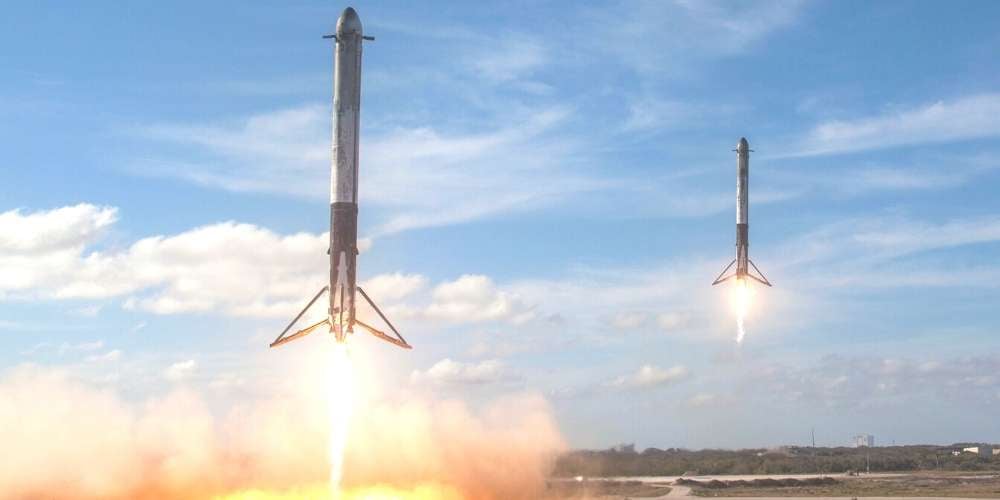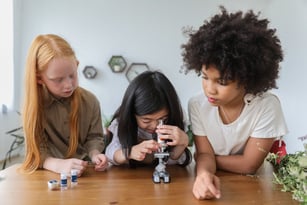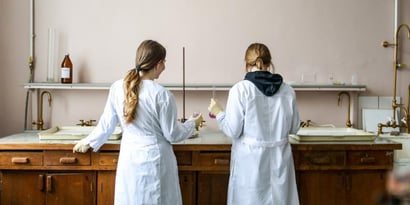Contents
- How to become an astronaut: qualifications
- How to become an astronaut: ESA or NASA
- How to become a SpaceX or Blue Origin astronaut
- Becoming an astronaut: social skills
- Astronaut training: psychological and physical requirements
- How much does an astronaut earn
If you have just asked your children one of the most difficult questions to answer, namely "What do you want to be when you grow up?" and in response, you got "How do you become an astronaut?", follow this short guide to learn what next steps to take to help your child explore space.
The path to becoming an astronaut can be diverse, incorporating a mix of knowledge and skills in different disciplines. Further, it is required to know a range of interpersonal and social skills. There are also physical requirements to be considered. These are the best steps your kid can take to become an astronaut.
Let’s take off! 🚀
How to become an astronaut: qualifications
Becoming an astronaut is one of the most incredible job paths one can take. The images of UK astronauts Tim Peake and Richard Garriott from the ISS, the International Space Station, are pretty awe-inspiring. 🌌
But how does one become an astronaut? It depends on the national or international agency of which you want to be a part of.
In the case of the UK, your child can aspire to work for ESA, the European Space Association or NASA.
NASA, which put a man on the moon 🌑 in 1969, is the American space agency and to work there you have to be a United States citizen.
At the international level, there is the ISS, International Space Station, which brings together Canada, Japan, Russia, the United States and 11 ESA European member states.
The UK Space Agency conducts experiments and research projects in cooperation with ESA and ISS, and for some projects, also with NASA.
Why are space agencies important?
They recruit potential astronauts and determine what skills and studies are required to become an astronaut.
One thing is certain, the qualifications required by all agencies to become an astronaut require a master's degree in a scientific subject:
- Natural sciences (physics, chemistry, biology, earth sciences)
- Mathematics
- Aeronautics
- Medicine
- Engineering (mechanical, aerospace, etc.)
How to become an ESA astronaut
Since 1978, the ESA has helmed three missions for European and UK astronauts. 👩🚀
To be one of the lucky few, you must pass a competitive selection test that can last several months and successfully complete a three-year training programme.
But before even thinking about the test, it is necessary to show the basic requirements to apply for the ESA astronaut competition:
- A solid academic background with at least a bachelor's degree in science subjects or engineering.
- As an alternative to a STEM degree, a pilot diploma from an official aviation school. Test pilot profiles are specifically sought after.
- At least three years of postgraduate work experience or a PhD.
A master's degree, i.e. a five-year degree, is certainly useful for working as an astronaut, but it is not enough. There are also transferable and social skills that are crucial to becoming an astronaut. 👾
How to become a NASA astronaut
NASA astronaut candidates have to meet the following requirements to be considered for the Astronaut program. The main obstacle is having U.S. citizenship.
- U.S. citizenship
- A master’s university degree in a STEM field such as math and AI computing
- 2 years of professional experience or 1000 hours of flight time logged as a pilot on jet aircraft.
- Pass the NASA Long-Duration Flight Physical
In terms of alternative qualifications for the role program, these are some options. ✏️
- Doctoral work spanning two years in a scientific field.
- Having completed a Doctor of Medicine or Osteopathic Medicine degree.
- Being enrolled or have graduated from a recognised test pilot flight school.
NASA training facilities
Astronauts in the U.S. get to use some cool facilities to learn to use space vehicles and tools.
Space Vehicle Mock-up facility
NASA has built models of its spacecraft so that astronauts can jump in and practice various technical procedures at different points in a mission, from launch to landing. It’s a sort of serious, grown-up playground. The mock-ups also let astronauts develop important problem-solving skills safely. 👾
Neutral Buoyancy Lab
The neutral buoyancy lab is essentially a big pool with space vehicle replicas in it. Astronauts get into the water wearing their spacesuits and this lets them practice their EVA (Extra Vehicular Activity) routines—basically what’s like to work in outer space while wearing a bulky spacesuit. 🧑🚀
KC-135 jet plane
This NASA aeroplane (a modified Air Force tanker) looks like a regular airliner from the outside. However, inside most of the seats have been taken out so that astronauts have room to get a feel for what low gravity is like. How can astronauts float in earth-gravity? You might ask. Don’t worry it’s not alien technology, just physics. 📈
The more you know
Here’s the secret: The NASA plane with its astronaut trainees on board flies a series of steep climbs and dives, like a rollercoaster but at a safe altitude. When the plane dives steeply, the NASA trainees inside get to experience a few seconds of weightlessness! ✈️
Precision Air-Bearing Floor
Reduced gravity in space sounds like a lot of fun but it can be a bit tricky if you are trying to move a heavy or fragile object without hurting yourself or damaging it. All while planet Earth is spinning right below you!
This is where the precision air-bearing floor comes in. The name makes it sound complicated but this is basically a life-size air hockey table. It lets astronauts get a feel for how objects move when there is no friction or gravity to stop them.
How to become a SpaceX or Blue Origin astronaut
How humans travel to space is changing quickly. Only a few years ago, space exploration was handled by government agencies like NASA and ESA, now private companies are starting to have an impact.
SpaceX and Blue Origin are two companies that have been in the news a lot. Let's take a closer look at what they do in space.
SpaceX
SpaceX was founded by Elon Musk and is best known for its reusable rocket technology which lowers the cost of sending humans and satellites into orbit.
SpaceX does not have its own astronauts currently. Instead, it is contracted by the United States to send NASA astronauts to the International Space Station (ISS). To become an astronaut that flies on a SpaceX rocket, you currently need to join NASA.
Blue Origin
Blue Origin was founded by Jeff Bezos, better known for starting Amazon, to lower the cost of space travel. Unlike SpaceX, Blue Origin does have its own astronauts.
Blue Origin astronauts get to space using the New Shepard reusable rocket. You only need a few days of training with Blue Origin to become an astronaut.
To become a Blue Origin astronaut, you can do one of the following:
- Fill out an application on the Blue Origin website.
- Join the Club For The Future.
Being selected as a Blue Origin astronaut is currently a long shot because flight slots are limited. Most recent Blue Origin astronauts have been wealthy individuals like Jeff Bezos himself, famous actors like William Shatner from Star Trek fame, and sponsored citizen astronauts selected by Space For Humanity.

Becoming an astronaut: social skills
Other minimum requirements for working at ESA include three basic skills:
- Flexibility, in dealing with irregular working hours as well as (space) travel and being away from family and loved ones
- Ability to remain calm and manage stress
- Willingness to participate in scientific experiments
Get your child to check out the UK Government web page about becoming an Astronaut so they can understand what it takes.
In particular, the ESA astronaut must be able to demonstrate:
Knowledge of languages
Speaking English plus a second language, and preferably, also a third language is highly desirable. Knowing Russian is an advantage, as it is the second official language of the ISS, but this is not compulsory–especially considering future space station plans.
Critical thinking and writing skills
Astronauts need to have very strong critical thinking skills. This is not just for scientific experiments but also for troubleshooting issues when things don’t go as planned. Likewise, writing skills are important since they need to accurately record and clearly communicate what they do, so others can learn from them. ☄️
Communication skills
An astronaut must be able to communicate in simple words to an audience of adults and children his or her expertise, the knowledge acquired, and the emotions they have experienced on their missions.
Decision-making skills
An astronaut's ability to react is mission-critical. Space agencies look for candidates who are able to make the right decision in a very short time by demonstrating excellent stress and risk management skills.
Those who are used to working in risky environments, such as the military or technicians working in emergency situations, certainly have transferable skills.
Teamwork
An astronaut’s team is composed of a combination of specialised professionals with a strong interdisciplinary background: such as biologists, physicists, mathematicians, engineers, botanists, test pilots and computer scientists.
Knowing how to work as a team, is therefore crucial to ensuring the success of a mission and the well-being of all crew members. Another very important aspect is the constant willingness to learn.
Astronaut training: psychological and physical requirements
Once selected, astronauts will have to undergo a period of education and training, including physical activity. Don't forget that to go into space, one must also demonstrate they can live in weightlessness and microgravity for extended periods of time. 🧑🚀
Those who already have flight experience are certainly at an advantage, but those who do water sports such as diving also have some advantages!
In the past, there were also precise physical requirements such as minimum and maximum height, which have now changed. The application period that closed in May 2021 was also open to parastronauts, i.e. astronauts with disabilities.
Astronauts must also be healthy from physical and psychological standpoints and not have any kind of addiction (drugs, tobacco, alcohol).
How much does an astronaut earn
If we look at the top-earning astronauts on space missions, the salary is around £80,000 per year.
Becoming an astronaut is all about loving your job, the prospect of scientific discovery, and technical achievements of spaceflight.
To help your children become astronauts, you can:
⭐ Generate curiosity for STEM subjects, from mathematics to science to engineering.
⭐ 1:1 tutoring can be great way to level up your child’s interest in maths and science. GoStudent tutors connect lesson topics to your child’s interests–such as becoming an astronaut.
⭐ Get them excited about other languages and cultures
⭐ Consider getting them interested in water-related or winter sports
⭐ Expose them to experiences that help them socialise, work in teams, share knowledge, express themselves correctly in writing and orally
So, what are you waiting for? Let your kid be ready to explore space! 🚀









